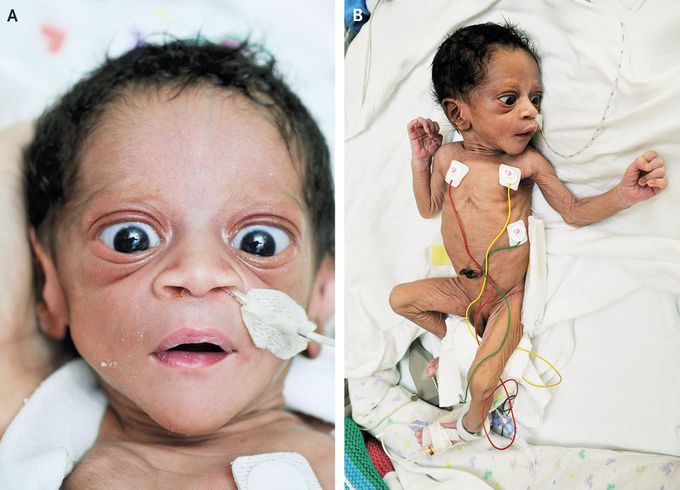


Neonatal Thyrotoxicosis
An infant born after 36 weeks of gestation was admitted to the intensive care unit and treated empirically for sepsis. His mother, who was 22 years of age, had been referred at 31 weeks of gestation for assessment of oligohydramnios. The fetal heart rate was 158 beats per minute. Ultrasonography was repeated every 2 weeks. At 35 weeks of gestation, intrauterine growth retardation was evident. No goiter was noted, and the fetal heart rate was 150 beats per minute. At birth, the boy weighed 1800 g. Apgar scores were normal, but the pulse was 200 beats per minute; no palpable goiter was present. Retraction of the upper eyelids was evident (Panel A), and subcutaneous fat was virtually absent (Panel B). One day after delivery the mother received a diagnosis of Graves' disease (hyperthyroidism). When asked about weight loss, the mother reported an unexplained weight loss of 28 kg during the preceding year, including a loss of 6 kg during pregnancy. Consequently, neonatal thyrotoxicosis was diagnosed in the infant, whose level of thyrotropin was less than 0.01 μU per liter (normal range, 0.5 to 5.0), free thyroxine, more than 70 pmol per liter (5.4 ng per deciliter; normal range, 14 to 30 pmol per liter [1.1 to 2.3 ng per deciliter]), and thyrotropin-binding inhibitory immunoglobulins, 56 U per liter (normal range, <1.5). The boy was treated with propranolol, methimazole, and potassium iodide. Within 5 days, free thyroxine levels normalized and the tachycardia resolved. Levothyroxine was added to the treatment regimen.
Good question! My guess is to prevent swinging the other way into hypothyroidism?


